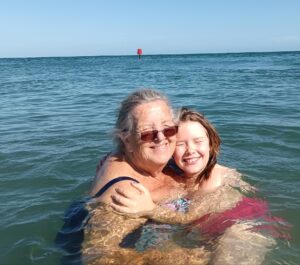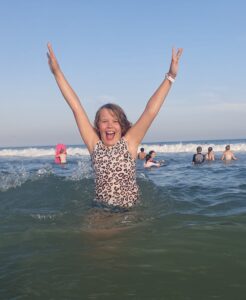
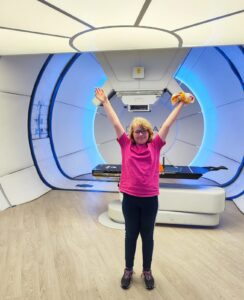
This is Julia’s story, our beautiful 9 year old girl. She’s had an incredibly tough few months but is still bouncing around smiling. Julia was diagnosed with a myxopapillary ependymoma on Friday 8th March 2024 at Crumlin Children’s Hospital in Dublin, a Grade 2 spinal tumour that usually occurs in middle aged men. This horrible thing had suddenly ruptured, causing excruciating pain as it pressed against various nerves.
The tumour was removed just a few days later through a lumbar thoracic laminoplasty on at Temple Street Hospital by “Taffy” – Ms Tafadzwa Mandiwanza. To prevent it growing back, Julia is currently receiving proton beam radiotherapy in Manchester. She started on June 5th and is romping though the treatments in great health. She is due to finish on the 11th July 2024, and I can’t wait to hear her ring that bell.
How it all started
Julia started having sporadic pains at the beginning of February. First, the back of her leg. Then the other. Her hip. Her knee! She started missing odd days off school but then would be 100% fine again for a few days.
Could it be psychological? Only one week before these strange pains started, I’d started a new job after years of being at home. Was Julia subconsciously trying to make me stay home with her?
We rang my sister, a physio in the US, hoping for exercises to ease the pain. Kath said it sounded like nerve pain, a pinch or pressure on a nerve somewhere. She was 100% correct, though it would take us weeks to find out why.
Julia couldn’t even attempt the exercises suggested. Her pain got worse. We went to our local GP. After the briefest of examinations, he sent us to A&E at Crumlin Children’s Hospital, saying Julia’s presentation had “red flags” all over it. We waited many hours.
They pondered hip dysplasia, common in her age group. The x-rays she needed were torture. She was howling out and having spasms of pain, even though the radiographer couldn’t have been gentler.
A young consultant eventually saw us. Julia’s x-rays were fine. She said Julia had a hamstring injury and would need physiotherapy. After 6 weeks, if Julia was still in pain, she would be given an MRI. I knew this was an unsatisfactory diagnosis, but we had been in the hospital for so long that we were just pleased to go home.
The week that followed was unbearable. Julia could barely sleep, only managing a couple of hours at a time sleeping slumped over the back of the sofa. Crying and pacing all the time. Shouting out. It was like being with someone in full blown labour. Julia’s already forgetting it, nature is gently erasing those dark days from her mind. Yet the agony of watching my daughter endure that level of pain will always stay in mine!
My 80 year old parents unwittingly arrived to stay with us for a 3 week holiday in the midst of all this. My dad in very fragile health. On day 2 of their trip, I took Julia back to the GP. He said “I’m not even going to examine this child. Go straight back to A and E. Don’t leave until you get an answer!” We went back to Crumlin, sure we would spend another terrible day waiting for hours with Julia in loads of pain, only to be told it was a hamstring injury again.
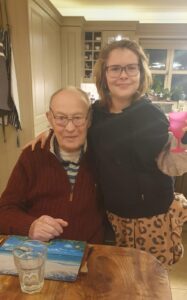
Diagnosis at Crumlin’s Children Hospital
This time, we were seen a bit quicker. Torturously, they wanted to x-ray her hips again. The x-ray machine could have literally been a bed of nails. It took half an hour to get 3 x-rays. Which came back clear.
Julia needed an MRI. There was a huge queue for the machine, plus it was temporarily out of order. The doctors wanted to admit her. The told me, if I took her home, it could be weeks until she had an MRI. At least if she was within the hospital system, it would be done as soon as possible.
The next few days were hell. Julia could barely lie down, day and night pacing the corridors groaning. They kept upping her medication, to little effect. One night, the ward sister said she couldn’t understand how Julia wasn’t unconscious, the amount of drugs she’d taken would have knocked out a fully grown man.
It sounds crazy now to think, but we were still wondering (and being asked) could this be psychosomatic. The pain moved around so much, but then also weirdly sometimes it would completely disappear. She’d be in full blown pain one minute, the next distracted by playing with other kids. And hot showers. One of the days, Julia was in the hospital shower 15 times! The scalding hot water would literally melt her pain away. Even the noise of the extractor fan seemed to calm her down.
They kept asking me about her mental health. About my job. About her past traumas. Notes were made. About her siblings, her worries, what could be causing all this. The thought of it being all her mind was terrifying. Had we entered some dark world of chronic pain with no physical cause, nothing that could actually be fixed?
Finally, the MRI machine was working. If Julia could just lie still for 40 minutes, she could have the MRI straight away. But, if she needed a general anaesthetic, we’d have to wait another couple of days. Having already been in hospital for 3 days, I was desperate to agree to her being able to lie down! To anaesthetise a child who’s acting out some drama in her head would have been horrendous. Surely she could lie still for 40 minutes.
We set off to the MRI simulator to have a practice. Julia couldn’t even walk the few corridors to get there. We had to take her in a wheelchair. The scene at the MRI simulator was hideous. I was so exhausted from days pacing hospital floors, preceded by sleepless weeks. Angry, frustrated, begging her to lie on the hard plastic bed of the simulator machine. Julia crying, shouting out in pain, unable to get anywhere near it. The play therapist trying to be gentle, trying not to force Julia to do anything, trying to calm us all down. We had to give up.
Julia wept and wept, saying how sorry she was. I was also crying, apologising, telling her that none of it was her fault. Even now, I feel so guilty for doubting her, for making her try to lie down when she was in so much pain.
We went back to the ward. As soon as we were away from the simulator, Julia was better, able to move and bend. My husband told me to bring her home. To give up. Abandon the whole thing, the hospital was making us both ill. We both needed sleep. But I couldn’t give up now.
After 2 more sleepless nights, Julia finally got her MRI under general anaesthetic, 5 days after admission. Having not left her side for days on end, once she was under the general, I stumbled off to the local shopping centre to buy some clothes. It was weird wandering around in sunny Crumlin, delirious with lack of sleep.
I assumed we’d get the results immediately. Then heard nothing for nearly 24 hours. I finally hijacked a consultant rushing through the corridor, a man I’d never seen before. He’d actually been on his way to find me. He took me into a side room. Then…I felt like I literally fell off the world.
Julia had a myxopapillary ependymoma in her spinal cord. A tumour 4cm long, 1 cm wide. The shape and size of a finger, probably growing there for years. It was in the “horse’s tail” part of her spine, where the spinal cord fans out into all the nerves that go to everywhere; legs, back, bowels, bladder, uterus etc. The tumour had ruptured and the swelling was pressing against her nerves. My sister had been right. Nerve pain. Horrifically painful, yet also distractable. Hot showers override the sensations. At least that made sense.
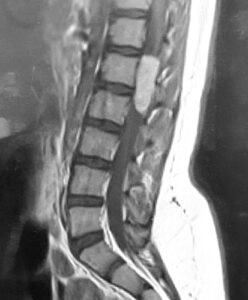
Julia needed immediate, risky surgery and then would require extensive radiotherapy, probably abroad. I was stunned.
In free fall, I rang my husband. I rang my mum. News radiated out across our network of family and friends in shockwaves.
I staggered off to find Julia. She was in a darkened sensory room, hanging out with a play specialist. Amidst fairy lights and sparkling drapes, I told her the diagnosis. She looked a bit worried but then smiled right away and said, “See! I told you it wasn’t my roller-skates!” And I laughed, because at least that was true. I hadn’t banished them to the bin yet and yes she’d be back on those teal wheels of pain in no time at all, fingers crossed.
That night, we were transferred by ambulance to Temple Street Hospital neurosurgery ward, lights flashing, siren blaring. So weird, bouncing through Dublin in full spate on Saturday night, teaming with people out on the tear, crowds that parted as we dived on through. Julia would have loved it if she’d been able to take any of it in. The driver had promised he’d take it slowly. I can’t imagine how fast he’d go in a rush!
The roads were so bumpy. Poor Julia was jolted around. The ambulance man gave her gas and air. She sucked on it hard, declaring Entonox was better than any of those rubbish drugs at Crumlin, why couldn’t she have had this the whole time? When she was finally wheeled into the ward, she was still sucking on it. They eventually peeled it out of her dazed and giggling hands.
Spinal Surgery at Temple Street Hospital
Sunday, we settled into our new surroundings, meeting the other kids on St Gabriel’s, a neurosurgery ward. Julia has been the only spinal case we’ve come across since the beginning of all this. We tried not to gawp at the children there for brain surgery with shaved heads, gnarly red scars, drips, wires and tubes. While a tumour isn’t great anywhere in your central nervous system, we felt lucky Julia’s was where it was.
She asked me, “Mummy, am I lucky or unlucky?” and the heart-wrenching truth is… she is both. So dreadfully unlucky to get a tumour at all, less than a one in a million chance of occurrence in a girl of her age but thank goodness it wasn’t in her brain and that we caught it before it could do any more damage.
Julia was immediately put on a drug called Gabapentin that within 24 hours had her pain in control. In the end, it wasn’t surprising the other medication hadn’t helped much. Nerve pain requires nerve blockers and once she was on them, the difference was huge. It would take time to build up in her system though. That first night in Temple Street, she was unable to sleep in her bed at all. She slept upright in a hospital chair. I guiltily enjoyed her hospital bed, my first night in a bed for a week! Poor Julia’s ankles were dangerously swollen the next day.
We met our fabulous Zimbabwean surgeon/superheroine Ms Tafadzwa Mandiwanza, usually just known as “Taffy”, Ireland’s first female paediatric neuro-surgeon. She showed me Julia’s MRI. There was the tumour. Clear, hard, white and wrong.
Taffy explained to us, her job was like getting a sausage out of a bowl of spaghetti. Tricky because the sausage needed to stay perfectly intact and not leak out any bits. Plus, you had to be very, very careful with the spaghetti. Every single noodle went somewhere crucial. The risks were worryingly high. Unthinkable possibilities. Paralysis, incontinence, infertility to name but a few.
Julia’s operation would be carried out as an emergency procedure on Tuesday 12th March. With over 24 hours to go, I begged one of the nurses to let me take Julia home, just for a night. The Gabapentin by then had her pain under control. The nurses reluctantly agreed, making me promise to sneak out and not tell anyone. We must be back by 8am the next day.
Julia was just able to walk. I had her packed up and on her feet in minutes. I drove her home as carefully as a newborn baby, supported on hospital pillows on my reclined passenger seat, hazards blinking across central Dublin. I inched the car over every pothole and speed bump. I didn’t breathe (or get out of 2nd gear) till we hit the n11.
We got home to Wicklow (10 days being admitted going to A&E) to my husband, my lovely parents, Julia’s brother and sister, and a whole bunch of her little friends who all rushed round for a cheerful busy hour, festooning her with kisses and cards, cakes and presents.
It was heaven to be home. My mum had cooked a creamy fish pie, piles of bright green broccoli, a million miles from tepid hospital food (so much of which had been greasy chips!) We got to see my lovely old Dad, who we’d sadly lose just a month later. Julia was in great form and so happy to see everyone.
But, as the house grew quiet and we got ready for bed, the pain loomed large again. Poor Julia had another awful night. Her Daddy took over so I could catch a few precious hours of sleep. At one point, he tried to lay underneath her on her bed to help prop her up, and had just got her comfortable when the bed collapsed!
However, one night at home was definitely worth it, at least for my sanity. We got up early and Julia was back in her gown and bed before the consultants did their morning rounds.
On Tuesday 12th March 2024, Julia had her operation. As she drifted off into anaesthesia sitting on the edge of the bed, I held her hands and sang about pink fluffy unicorns dancing on rainbows. Her little body relaxed back into the nurses’ arms. They gently laid her down flat, her poor back straightening for the first time in weeks.
I staggered out into a beautiful sunrise, Dublin just waking up, all bread vans and beer deliveries. I walked across North Dublin to my friend’s house and collapsed into a few hours of dreamless sleep, the future of my youngest child entirely someone else’s responsibility.
Julia’s operation was a lumbar thoracic laminoplasty of a myxopapillary ependymoma. Her surgeon, Taffy, made a long incision down her spine, removed a section of vertebrae, opened Julia’s spinal column and took “the sausage out of the spaghetti” – the horrible tumour out of the tangle of critical nerves. Then, Taffy clipped back in the vertebrae with titanium plates and stitched her all up again. The operation took 5 hours.
Afterwards, Taffy told me the operation had gone really well. No nerve damage, thank god. Taffy was confident she had got out all of the tumour. But… (Argh! No one wants to hear any buts!!) It hadn’t been perfect. The tumour had broken up a bit during the removal. Taffy was sure she’d got out all of the pieces, but Julia was going to need radiotherapy. She would have needed it as a precaution anyway, but now it would be essential to prevent regrowth from any tiny bits left behind in the spinal fluid.
Julia would need 6 weeks proton beam radiotherapy either in Germany or the UK, about 6-8 weeks after the surgery. Radiotherapy would have some side effects, making Julia tired and possibly lowering her towards the end of the treatment, but it would be nothing like chemotherapy.
For three days after the surgery, Julia had to lie flat on her back, unable to move her legs. It was a scary time for us, wondering had all that critical “spaghetti” really remained intact. We watched a blur of Disney movies together lying flat out on Julia’s hospital bed, her amazing bendy-arm hospital TV positioned right in front of our faces.
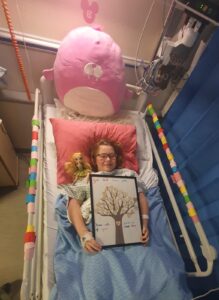
Suddenly Julia was up. On her feet. Baby steps around the bed. The relief! Then to the loo, me shadowing her every step. Then by herself! Walking slowly. Up and down the corridor. Then dancing. We were allowed home just 5 days after the operation. Julia would need two weeks to recover at home, then be as right as rain.
We packed up her bags of things, teddy bears and good luck messages. A porter helped us down to the car, bringing Julia in a wheelchair. We had another surreally slow drive out though central Dublin, Julia reclined on a pile of pillows, me impervious to the frustration of other drivers, finding our way through the Patrick’s Day drinkers and rugby supporters thronging in the streets around Lansdowne Road.
This part was finally over! I don’t think having a hot shower and going to bed has ever been so good.
The Essen / Manchester Dilemma and an anxious few weeks
We’d been told Julia would need proton beam radiotherapy 6-8 weeks after her surgery, an advanced type of radiotherapy used on patients who’d suffered tumours in their central nervous systems as it could be more targeted and precise. Proton therapy is not available in Ireland, so we would need to travel to either Essen in Germany or Manchester in the UK.
We were terrified by the unknown expenses of what it all would cost, how much we would be liable for, what would be covered. Right from the start, we were told about The Gavin Glynn Foundation (GGF), an Irish charity that supports the families of children requiring cancer treatment overseas. We were told they’d help us with flights, accommodation and expenses. We didn’t really believe it. We still weren’t even sure had our health insurance or the HSE paid for Julia’s spinal surgery.
John, the founder of GGF, was in contact right from the start, a friendly email flew in saying as soon as we knew where Julia was going to be treated and had our initial dates, GGF would sweep in and sort out all the details.
We had a meeting with oncology at Crumlin. We were advised that choosing Essen, Germany would be easier in terms getting seen quickly as they’re well set up for receiving EU patients. Manchester would be trickier, longer waiting lists, of course they had to prioritise NHS patients. Much easier to go to Essen.
Originally, I agreed to this. But, as the weeks wore on, my dear old Dad in England got increasingly sick. I realised I couldn’t cope with being stuck in Germany and not being able to get to him or my Mum if I needed to be there.
I rang our medical social worker who changed all our paperwork and transferred our referral. I’m so glad that we made that change! The ease and convenience of being in England, where we speak the language, have family, understand how things work, has been completely brilliant.
Weeks wore on and we still had no treatment start date. My Dad suddenly got worse. I flew back and forth to be with him and had the honour to be with him when he actually passed away. Dad adored Julia, his youngest granddaughter, and asked all about her treatment even while he was so poorly himself.
6-8 weeks passed. The window for her treatment post-surgery seemed was extended to 9-12 weeks. Was this getting too late to be effective? Maybe we should switch back to Germany now Dad had actually passed?
Julia was getting on great, happily bouncing around again at school with her friends, dancing, cartwheeling, even back on her roller skates. Pretty much back to her old self, except for the huge scar up her back and limited flexibility in her back. My husband and I were getting twitchy. Treatment could begin with just one day’s notice. This week? Or next? Organise normal life things, or put it all on hold? What about work?
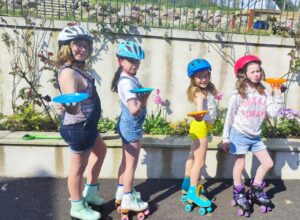
Suddenly, with just 2 days’ notice, we had an initial meeting date. Two days at the Proton Beam Therapy Centre in Manchester for Julia to meet the team, therapy likely to start the week after.
GGF swept in and just magically sorted all the details. Flights, taxis, accommodation, all booked and organised. Last minute changes, sorted. Us not having to worry about ANY of the details. They were Iike our own personal travel agency. We couldn’t believe it. There was a lot else to worry about in terms of managing the other kids / our jobs / the house etc, but the travel logistics were magically sorted for us!
Initial review at the Proton Beam Therapy Centre, Manchester
For our first trip to Manchester, we were met by Niamh, an Aer Lingus flight attendant who volunteers for TGGF. She met us at the entrance to the airport, immediately noticing that our flight to Manchester was delayed. She said when a flight starts getting delayed like that, there’s a risk of it being cancelled. She promptly had us rerouted to Birmingham. John would have a taxi there to meet us to bring us to Manchester. Amazing. It would be a late night, but we’d make it!
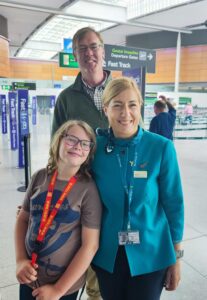
Niamh gave us the rockstar treatment through Dublin airport, sweeping us through fast-track security, telling us all about her son who had proton therapy in Essen and his fantastic recovery. We boarded the plane first, feeling like celebrities and the pilots showed Julia straight in to sit in the cockpit!
We were settled into our seats by another lovely Aer Lingus flight attendant, who treated us to drinks and snacks and made Julia feel like a star.
From Birmingham airport, a friendly taxi driver whizzed us west to Manchester. We settled into our 2 bedroomed apartment at StayCity, a huge city-centre hotel. It was late. I quickly got Julia to bed, drawing the heavy curtains against the bustling hub bub of the streets below. I gratefully downed the prosecco and looked over some of information for the next day.
After plane snacks for breakfast, we took the shuttle bus to the Proton Beam Therapy Centre, a cheerful service that runs several times a day. Funny, friendly bus drivers, lots of regular passengers, we’d get to know this service very well in the future!
Julia was immediately welcomed in and shown round by play therapists, who explained all her treatment to her with teddys and simulators. She even got to give a poor teddy a canula! We met her consultant, Dr Gillian Whitfield, and the radiographers.
The whole £125 million centre is built round the 3 storey proton beam machine. But the centre was designed with a panel of kids to help get the priorities right, so the main areas are playrooms. The actual proton treatment is delivered in 3 white rooms that are like something out of a sci-fi movie. The patient lies on a bed and receives the beam of magical protons from a tiny nozzle of this giant machine, that can be aimed at from a full 360 rotation around the bed.
After 2 days of play specialists, poking and prodding, a blood test, another MRI (a piece of cake this time!), we flew back to Ireland, for a few days at home and Julia’s last 2 days of school, before the real treatment was to begin the next week.
It’s hard to think that just a couple of months before this, there we all were rocking along in the chaotic, cheerful clatter of busy everyday life to find ourselves here. White-knuckling through an emotional roller-coaster of days. Trying to not to howl in these quiet hospital halls.
The kindness and generosity we’ve met along this journey keeps just keeps flooring me. Not just from TGGF whose massive support has allowed us to make this the best possible experience for Julia, but from the kindness of so many of the everyday people we’ve met along the way.
I often feel fraudulent, like we don’t really deserve all this, not all this help from TGGF, not everyone’s sympathy and kindness, sure Julia is going to be fine, she is not as bad as the others, we’re in a better position in most, but none of that matters.
In honesty, we’re reeling, just as is every family we’ve met here. Our world has been flipped upside down by Julia’s diagnosis. Her tumour is rare, yet amongst any population, a statistical certainty. But why, oh why, did it have to be her?
TGGF have just helped us so much with the cost of it all but more importantly by just taking over ALL the details. To bring Julia’s siblings over for a weekend. To have a last-minute flight rescheduled because of a closed airport, a taxi booked or changed. To have money for expenses, both humdrum or crucial but for fun times too. We got great seats to see Aladdin, a super West End musical production at the Palace Theatre that enthralled us for 3 hours in a happy cloud of blue glitter. We’ve been to Chester Zoo. Last minute train tickets to the south coast. Meals out as a family. Ice-creams. With EXTRA sprinkles.
Because of GGF, we’ve been able to concentrate on Julia and being right here for her, and that’s a full-time job. We are just so grateful to the army of helpers and fundraisers behind the scenes who make all this possible. Who have sent 265 Irish families abroad for life-saving treatment ahead of us.
But most of all, and from the bottom of our hearts, thank you John and Jayne!
Update
Julia’s now 3 weeks in. She’s made a BFF, another 9 year old who started around the same time. They bounce around the centre together, loving the individual attention at the hospital school, and are up and down to each other’s apartment’s every evening.
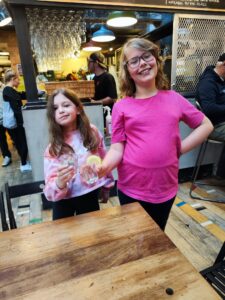
There’s a lovely camaraderie between the families at StayCity, we’re getting to know each other. I’m loving the support from meeting other parents. The other day, we had 4 families go together to the playground, all different ages and stages, all of us just trying to put one foot in front of the other and take each day as it comes. There must be 3 other Irish families currently at the Centre, all receiving help from TGGF. Just incredible.
Julia’s had 20 of 28 treatments so far. The area on her back where she’s receiving the treatment is beginning to look darker, like a large, tanned patch, but not sore or red. Just in the last few days, I’ve noticed that she’s getting a little more tired. She’s slightly less hungry than her usual, ravenous self, but still eating well and doing absolutely great.
This morning, we left Manchester at 9am after her treatment and took a train all the way to the sunny Southeast. Away from Manchester’s machines and beams, traffic and trains, all the way to home-made scones at her Granny’s and into the sparkling clear waters of the sea.
